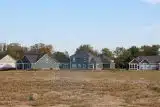Siding: Which Material To Use And When To Replace It
General
Posted by: Tyler Miller 1 year ago
Siding is more than just the outer skin of your home. It protects against the elements, insulates, and significantly contributes to your home’s curb appeal. With so many materials available and factors to consider, deciding on siding repair or replacement can be daunting.
This guide will navigate the many siding options available and help you determine when it’s time for an update.

Choosing the Best Siding Material
Your choice of siding material will impact your home’s appearance, durability, maintenance level, and insulation properties. Here’s a breakdown of popular siding materials:
- Vinyl Siding: Affordable, versatile, and low maintenance, vinyl siding is a favorite among homeowners. It comes in various colors and styles but can crack under extreme temperatures.
- Wood Siding: For a classic and timeless look, wood siding is unparalleled. It requires more maintenance to prevent rot, pests, and water damage but offers natural beauty and insulation.
- Fiber Cement Siding: Mimicking the look of wood, stucco, or masonry, fiber cement siding is durable, fire-resistant, and termite-proof. It’s more expensive than vinyl but less maintenance-intensive than wood.
- Metal Siding: Aluminum and steel siding are durable, fire-resistant, and recyclable. Metal siding is ideal for modern architectural styles and coastal homes, offering excellent resistance to salt air.
- Stucco Siding: Traditional and durable, stucco is made from cement, sand, and lime. It’s ideal for arid climates and offers a unique texture and appearance.
When To Replace Your Siding
Visible Damage: Signs of Wear and Tear
Cracks and Gaps: Even small cracks can allow water to penetrate beneath the siding, leading to more significant damage over time.
Warping and Bulging: These are often signs of moisture trapped underneath the siding, indicating that it’s not just the surface that’s affected.
Rotting or Soft Spots: For wood siding, soft spots or rot are clear indicators that the siding is no longer providing adequate protection.
Moisture, Mold, or Mildew Inside Your Home
Interior Water Damage: Peeling paint or wallpaper inside your home can be a sign of siding failure allowing moisture in.
Visible Mold and Mildew: These not only affect the home’s structure but also pose health risks to the occupants.
Fading and Discoloration: Signs of Aging
Excessive Fading: Siding that has lost its color significantly may have reached the end of its UV resistance, suggesting it’s time for an update.
Frequent Need for Painting: If you find the need to repaint your siding more often than every 8-10 years, this could indicate underlying problems with the siding material itself.
Increased Heating or Cooling Bills: Insulation Issues
Sudden Spikes in Energy Costs: Unexplained increases in your bills can indicate poor insulation, often due to old or damaged siding.
Drafts Near Walls and Windows: Feeling drafts even when windows are closed can be a sign that the siding is not effectively keeping air sealed in.
Pest Infestations: Structural Vulnerabilities
Holes and Gaps: Small holes or gaps might be entry points for insects or small animals, suggesting the siding is compromised.
Nesting Materials or Droppings: Signs of pests, such as nesting materials visible in gaps or droppings along the siding, require immediate attention.
Additional Considerations
Age of Siding: Knowing the typical lifespan of your siding material can help anticipate replacement needs.
For example, vinyl siding lasts about 20-40 years, while wood siding might need replacement or significant maintenance every 10-20 years depending on the climate and maintenance history.
Noise: Increased noise penetration can also be a sign of siding failure, indicating gaps or deterioration in the siding’s ability to insulate from external sounds.
Watch for Warning Signs
Keeping an eye out for warning signs that your siding needs replacement is key to maintaining your home’s integrity and appearance.
Regularly inspect your siding for any visible damage like cracks, warping, or rot, and be alert to interior signs such as peeling paint or increased humidity, which could indicate moisture infiltration.
Fading color, increased energy bills, and evidence of pests are also critical indicators that your siding may be failing. Addressing these issues promptly can prevent minor concerns from escalating into major repairs.
For a thorough assessment and expert advice, consider reaching out to professionals like Timber Rock Construction to ensure your home stays protected and looks its best.
Consult a Professional
Ready to discuss your siding options or think it’s time for a replacement?
Contact Timber Rock Construction today to explore our services and how we can help enhance your home’s exterior with the perfect siding solution and renovation options.
Categories:
You May Be Interested In:

How to Choose the Perfect Plot of Land For Your Custom-Built Home
2 days ago by Tyler Miller

The Long-Term Benefits of Energy-Efficient Home Design
2 weeks ago by Tyler Miller

One vs. Two-Story Homes: Which Is Best For You?
1 month ago by Tyler Miller

Designing Outdoor Living Spaces to Complement Your Custom Home
1 month ago by Tyler Miller